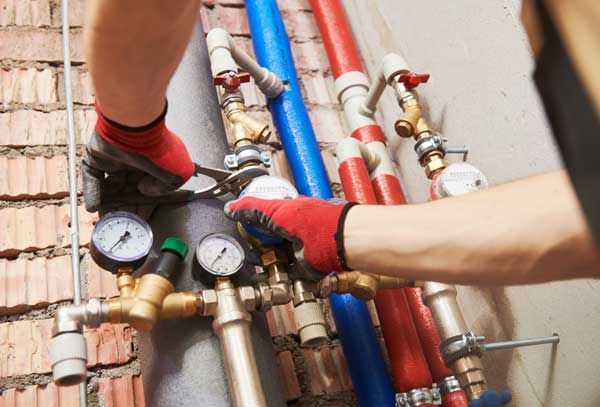How do you actually feel about 11 Must-Read Tips for Plumbing a New House?

For new home owners, understanding and preserving bathroom pipes can save both money and time by avoiding costly concerns down the line. Right here are some essential shower room plumbing ideas to help you maintain everything running smoothly.
Get Ready For Cold Weather
Secure your pipes from freezing throughout cold weather by insulating pipelines in unheated locations like basements, attic rooms, and garages. During extreme cool, let cold water drip from faucets offered by exposed pipelines to assist prevent cold.
Set Up Regular Maintenance
Think about scheduling annual inspections with an accredited plumbing technician. They can find concerns that you might miss out on, such as hidden leaks or damage on pipes and components. Routine upkeep helps prolong the life of your pipes system and can avoid emergency situations.
Acquaint Yourself with the Key Shut-Off Valve
Understanding where the major water shut-off valve lies in your house is vital. This allows you to swiftly switch off the supply of water in case of significant leakages or during pipes emergencies, avoiding comprehensive water damage.
Frequently Evaluate for Leaks
Little leakages can bring about big issues. Frequently inspect under sinks, around commodes, and near plumbing fixtures for any indications of leaks. Try to find wetness, tiny drips, or corrosion. Catching and repairing leaks early can avoid a lot more severe damages and conserve water.
Keep Your Water Heater
Ensure your water heater is set to an appropriate temperature (generally around 120 degrees Fahrenheit) to avoid scalding and decrease energy usage. Flush the tank yearly to remove sediment accumulation, which can minimize the performance and life expectancy of your heating unit.
Update Your Fixtures
If your home has older fixtures, consider upgrading to much more efficient models. Modern toilets, showerheads, and taps are created to utilize less water while providing excellent stress, which can dramatically minimize your water expense and environmental footprint.
Beware with DIY Plumbing Services
While it's alluring to manage all home repair services on your own, be cautious with pipes. Some problems may require expert knowledge, especially if they involve main water lines or sewer repair services. Employing a professional can sometimes be a lot more affordable than DIY, specifically if it stops additional damage.
Do Not Overlook Slow Drains Pipes
If your sink or bathtub is draining pipes gradually, it's usually an indicator of a blockage forming. Addressing this very early can stop a complete clog. Utilize a plunger or a plumbing technician's serpent to remove particles. Stay clear of making use of chemical drain cleansers as they can damage your pipelines with time.
Know What Not to Flush
Commodes are not waste disposal unit. Stay clear of flushing anything other than bathroom tissue and human waste. Products like wipes, feminine hygiene items, and cotton swabs need to be dealt with in the garbage to avoid obstructions and sewer back-ups.
Install Strainers in Drains
Location filters in your sink and tub drains pipes to catch hair and various other debris before they enter your pipes system. Cleaning the filters regularly will assist protect against accumulation and maintain water flowing easily.
Verdict
Understanding and preserving your home's bathroom plumbing can protect against numerous typical concerns. By following these vital pointers, you can ensure your shower room remains practical and effective, conserving you time and money in the long run.
5 Plumbing Tips for First-Time Homeowners
Know How to Shut Off the Water
In most homes, the water can be shut off at two places: at the appliance or fixture itself, and for the whole house. For instance, look under your sink or behind the toilet. See those little knobs that connect with the pipes? Those are the shut off valves for those fixtures. Simply turn them until the water is off. The main shut off valve (which controls water throughout your entire home) will be outside, where the water feeds into the structure. You might need a dedicated tool, such as a water shut-off key, to shut off the water at the main.
Build an Emergency Plumbing Kit
Everyone knows how important it is to have a high-quality plunger around the house. But there are other things that can help you out when issues arise with the pipes. Building an emergency plumbing kit to solve issues on your own is part of any list of basic plumbing tips. Consider adding these things to create a basic plumbing kit:
Adjustable wrench Tongue-and-groove pliers Screwdrivers Plumber’s tape Pipe sealant Duct tape Set of hex keys Clip light for working under cabinets Auger and hand snake Do a Little Research
Many small leaks can be handled by replacing a small part of the piping system, tightening part of a faucet, or even changing out an aerator. Take the time to browse how-to articles for common plumbing problems, such as a running toilet or slow-draining sink. You might be surprised to find how easy it can be to do simple things yourself, like replace a valve in the back of the toilet.
Keep it Simple With No Chemicals
If you have a clog, you might be tempted by the promises of liquid drain cleaner. While this might work at first, it actually causes more damage deep in the pipes, eventually creating even more problems down the road.
Instead, try using baking soda and vinegar to create a strong fizzing effect that can help break up clogs and clear gunk from drains. Follow it with boiling water to clean the pipes even more thoroughly.
Take Care of Your Garbage Disposal
Be cautious about what you put down the disposal. Avoid pouring in fats, oils, and grease, as these are a surefire way to get a clog. Beware of certain foods too, such as celery or bones, as they can lodge in the works. Always run the disposal with water flowing.
https://modernize.com/homeowner-resources/other/10-plumbing-tips-for-first-time-homeowners

Get A Free Quote